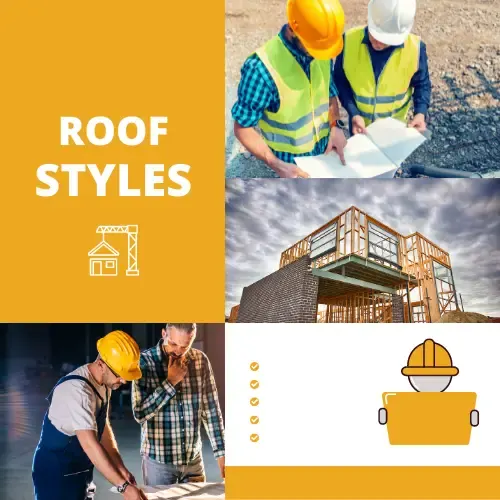
When it comes to your home’s exterior, the roofline style is a critical element that can greatly impact its overall look and functionality. As a seasoned roofer, I’m here to highlight the importance of choosing the right roofline style for your house.
It is essential to mention right off the bat that your roofline style is not just a matter of aesthetics; it plays a significant role in the functionality of your home. Take, for example, the classic gable roofline. Its triangular shape allows for efficient rainwater runoff, making it a great choice for areas with heavy rainfall. On the other hand, a flat roofline may not be the best option in such regions, as water can accumulate and lead to potential issues if not properly managed.
That being said, whether you choose a Dutch gable roof or a hipped roof, it will inevitably impact your home’s curb appeal. The roofline style you choose can dramatically change the look and feel of your house. A traditional gable roofline exudes timeless charm, while a modern shed roofline offers a sleek and contemporary appearance. When considering a roof, it is worth thinking about the architectural style of your home and how the roofline can complement it.
Moreover, different roofline styles can provide additional living or storage space. A hip roofline, for instance, creates attic space that can be converted into bedrooms or storage rooms, maximizing your home’s utility.
The other thing that matters is how your roof was built and the material used. We have an article that explains everything you need to know about residential roofing.
Bonnet Roof
A Bonnet Roof, also known as a kicked-eaved or swept roof, is a distinctive architectural design characterized by its two slopes on all sides. Think of it as a fusion between a half-hipped roof and a gable roof (we discuss these styles below). The lower slope of the Bonnet Roof is steeper than the upper one, creating a visually appealing overhang. This overhang serves a dual purpose, providing shade and protection from the elements while adding an elegant touch to your home.
Advantages of Choosing a Bonnet Roof
Weather Resilience: Bonnet Roofs are known for their excellent weather resistance. The steep lower slope helps drain rainwater quickly, preventing leaks and water damage. This feature is particularly beneficial in areas with heavy rainfall or snowfall.
Enhanced Ventilation: The overhang of a Bonnet Roof creates a natural ventilation system. It allows warm air to escape from the interior, keeping your home cooler in hot weather. This can lead to energy savings, thus lowering cooling costs in the summer.
Aesthetic Appeal: Bonnet Roofs exude timeless charm and character. They can complement various architectural styles, from colonial to Mediterranean, making your home unique.
Extra Outdoor Space: The overhang provides a sheltered area around the home, perfect for creating a cozy porch or patio. It’s an ideal spot to enjoy the outdoors, even when the weather is less than perfect.
Practical Applications
Residential Homes: Bonnet Roofs are a fantastic choice for residential properties, especially if you want to add elegance to the home’s design.
Porches and Entryways: The overhang of a Bonnet Roof can transform your porch or entryway into a welcoming and protected space.
Historical Buildings: Many historical buildings and landmarks feature Bonnet Roofs due to their classic appeal and functionality.
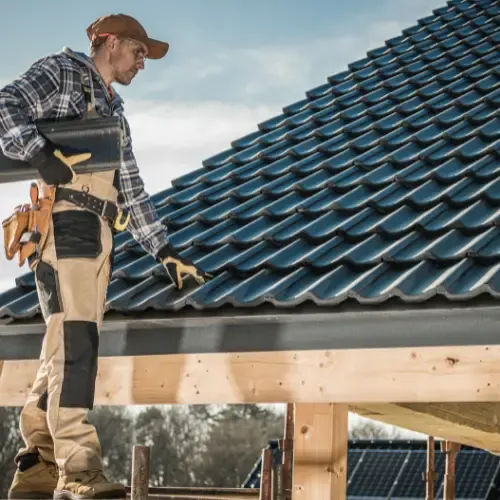
Box Gable Roof
A Box Gable Roof, also known as a Boxed Eave or a Closed Gable Roof, is a classic roofing style characterized by its triangular gable at each end. Unlike traditional gable roofs with open, exposed gables, the Box Gable Roof features enclosed gables, creating a clean and polished look. It’s a fusion of functionality and aesthetics, making it a popular choice for various architectural styles.
Advantages of Choosing a Box Gable Roof
Enhanced Curb Appeal: The clean lines and symmetrical design of Box Gable Roofs instantly boost the home’s curb appeal. It adds a touch of sophistication and elegance that can’t be overlooked.
Weather Resistance: The enclosed gables protect against the elements, preventing moisture, debris, and pests from infiltrating the attic space. This design helps extend the lifespan of your roof.
Versatility: Box Gable Roofs are incredibly versatile and can complement various architectural styles, from modern and contemporary to traditional and colonial.
Potential for Ventilation: The triangular gable ends offer an opportunity for proper attic ventilation. This can help regulate indoor temperatures, reduce energy costs, and prevent moisture buildup.
Practical Applications
Residential Homes: Box Gable Roofs are an excellent choice for residential properties seeking a timeless and visually appealing roof design.
Garages and Outbuildings: If you have a detached garage or outbuilding, a Box Gable Roof can add a touch of sophistication while providing reliable protection.
Commercial Buildings: Many commercial buildings opt for Box Gable Roofs due to their sleek appearance and functionality.
Note: The box gable roof shouldn’t be confused with the gambrel roof, as these are two different roof styles.
Butterfly Roofs
A Butterfly Roof, also known as a V-roof, is a roof design that resembles a butterfly’s wings in flight. It features two upward-sloping roof surfaces that meet at the center, creating a distinctive V-shape. This bold and modern architectural choice is gaining popularity for its striking appearance and functional benefits.
Advantages of Choosing a Butterfly Roof Shape
Architectural Marvel: Butterfly Roofs are a statement piece. Their unconventional design captures attention and sets your property apart from the rest. If you’re an architecture enthusiast or love unique designs, this roof style is a conversation starter.
Natural Light and Ventilation: The central V-shaped valley of a Butterfly Roof creates a natural skylight and ventilation channel. You can install large windows or even a glass panel to allow abundant natural light into your living spaces while promoting air circulation.
Rainwater Harvesting: The V-shaped design funnels rainwater towards the center, making it ideal for rainwater harvesting systems. It’s an eco-friendly option that reduces your water bills and carbon footprint. That’s why it is one of the more modern roof shapes that’s gaining popularity.
Practical Applications
Modern Homes: Butterfly Roofs are an excellent fit for modern and contemporary homes. They lend a sleek and futuristic vibe to your property.
Eco-Friendly Homes: If you aim for a sustainable lifestyle, the Butterfly Roof can be integrated into green building designs, incorporating solar panels and rainwater harvesting systems.
Commercial Spaces: Many commercial buildings and art studios opt for Butterfly Roofs due to their artistic and functional appeal.
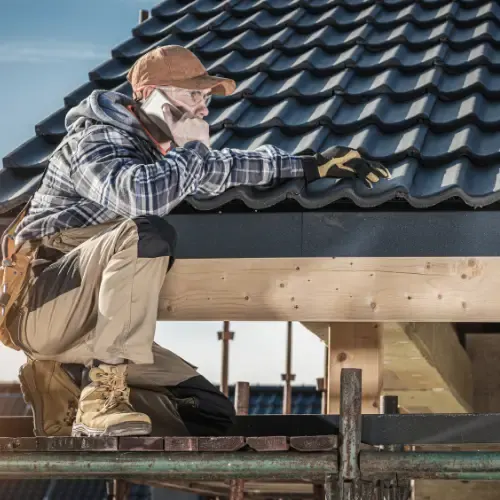
Clerestory Roof
A Clerestory Roof is an architectural design that features a row of windows, or a band of glass panels placed high on a wall or along the top section of a roof. This design allows natural light to flood into your space from above, creating a breathtaking effect. It’s like having your own private sunroof.
Advantages of Choosing a Clerestory Roof
Abundant Natural Light: The primary advantage of a Clerestory Roof is the ample natural light it provides. This reduces the need for artificial lighting during the day, saving energy and creating a warm, inviting atmosphere.
Privacy and Views: You get to enjoy natural light and outdoor views without sacrificing privacy. Clerestory windows are strategically placed, ensuring your neighbors won’t have a front-row seat view into your home.
Architectural Elegance: Clerestory Roofs add a touch of sophistication and uniqueness to your property. They’re a stunning architectural feature that can become the focal point of your home, provided that the suitable roofing material is used.
Practical Applications
Living Spaces: Incorporate Clerestory Roofs in your living room, kitchen, or bedroom to create a well-lit and visually appealing environment.
Art Studios: Many artists and creators prefer Clerestory Roofs for their studios, as the natural light enhances creativity and showcases their work beautifully.
Commercial Buildings: Clerestory Roofs are also common in commercial spaces like museums, churches, and libraries, where they offer both aesthetic and functional benefits.
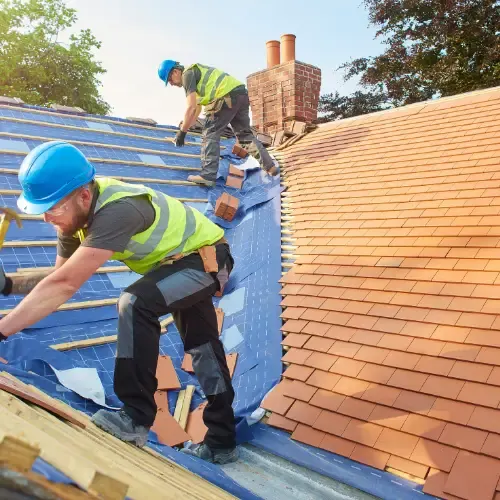
Combination Roof
A Combination Roof, as the name suggests, is a roofing style combining two or more different types of roof designs. This blend of roofing elements creates an eye-catching and versatile architectural masterpiece. It’s like having the best of multiple worlds baked into one roof.
Advantages of Choosing a Combination Roof
Aesthetic Appeal: Combination Roofs are visually striking. You can create a customized look that suits your architectural preferences by merging different roof styles.
Functionality: Each roof type within a Combination Roof can serve a specific purpose. For instance, a gable roof section may provide excellent ventilation, while a hip roof section can enhance stability and resistance against strong winds.
Space Utilization: Combination Roofs allow for innovative space utilization. You can design unique interior layouts, such as cathedral ceilings or vaulted spaces, thanks to the varying roof heights and angles.
Practical Applications
Residential Homes: Combination Roofs are ideal for residential properties looking to stand out with a one-of-a-kind roof design. Imagine combining a gable roof with a shed roof to create an elegant and functional living space.
Commercial Buildings: Many commercial establishments use Combination Roofs to make a statement. For instance, a restaurant might blend a flat roof with a butterfly roof for a stylish and distinctive look. The same goes for combining it with a skillion roof or something similar.
Historical Preservation: When restoring historical buildings, Combination Roofs can replicate the original design while incorporating modern structural elements for durability.
Cross Gabled Roof
A Cross Gabled Roof is a captivating architectural design characterized by two or more gable roofs intersecting at right angles. Picture the letter “T” or “L” in your mind, and you’ll get the idea. This roofing style adds a timeless appeal to your property and provides functional advantages that set it apart.
Advantages of Choosing a Cross–Gabled Roof
Distinctive Aesthetic: The intersecting gable roofs create a visually stunning effect, giving your home a distinctive and captivating look that stands out in the neighborhood.
Enhanced Ventilation: The multiple gable peaks provide excellent ventilation. Hot air rises and escapes through the gable ends, ensuring your home stays cooler in the summer months.
Increased Interior Space: The peaked rooflines offer an opportunity to expand the interior living space. You can utilize this extra room for a cozy attic, additional bedrooms, or storage.
Practical Applications
Residential Homes: Cross Gabled Roofs are a perfect fit for various architectural styles, from Colonial to Cape Cod. They can enhance the curb appeal and functionality of your home.
Garages and Outbuildings: Extend the charm of a Cross Gabled Roof to your garage or outbuilding, creating a cohesive and stylish property.
Historical Renovations: Many historical buildings feature Cross Gabled Roofs, making them an ideal choice for preservation and restoration projects.
Cross Hipped Roof
A Cross Hipped Roof is a roofing style that combines the features of a hipped roof with the addition of a gable roof at right angles to one or more sides. Picture the traditional hipped roof with its sloping sides, and then add a gable at the end – that’s a Cross Hipped Roof. This design offers a unique blend of architectural appeal and practical benefits.
Advantages of Choosing a Cross-Hipped Roof
Exceptional Aesthetics: Cross-hipped roofs add a touch of sophistication to your home’s exterior. The combination of hipped and gable elements creates a captivating and balanced look.
Efficient Water Drainage: The hipped sections of the roof ensure efficient water drainage, reducing the risk of leaks and water damage during heavy rains.
Increased Attic Space: The gable portions of a Cross Hipped Roof can provide valuable additional attic space. This space can be used for storage, an extra bedroom, or a cozy home office.
Practical Applications
Residential Homes: Cross-hipped roofs are an excellent choice for architectural styles, including Colonial, Ranch, and Cape Cod homes. They can enhance the curb appeal and functionality of your property.
Garages and Outbuildings: Extend the charm and benefits of a Cross cross-hipped roof to your garage or outbuilding, creating a cohesive and stylish property.
Historical Preservation: Many historical buildings feature Cross Hipped Roofs, making them an ideal choice for preservation and restoration projects.
Curved Roof
A Curved Roof, as the name suggests, is a roofing style that features a gentle curve or arch in its design. This architectural marvel is like a work of art that can transform the ordinary into the extraordinary. Whether aiming for a modern masterpiece or a classic gem, a Curved Roof can deliver both form and function.
Advantages of Choosing a Curved Roof
Aesthetic Excellence: Curved Roofs are showstoppers. Their graceful, flowing lines add a sense of grandeur and uniqueness to your property, making it stand out in the neighborhood.
Superior Drainage: The curve of the roof helps with efficient water runoff, reducing the risk of ponding and leaks. This design is especially beneficial in areas with heavy rainfall or snowfall.
Energy Efficiency: The curved shape can accommodate more oversized windows or skylights, allowing more natural light to flood your interior spaces. This reduces the need for artificial lighting during the day and can result in energy savings.
Practical Applications
Residential Homes: Curved Roofs are an excellent choice for residential properties looking to make a design statement. Whether you’re building a new home or remodeling an existing one, a Curved Roof can add unmatched elegance.
Commercial Buildings: Many commercial spaces, such as museums, art galleries, and modern offices, embrace Curved Roofs for their aesthetic appeal and functional advantages.
Event Venues: Curved Roofs can be seen in event venues like amphitheaters, creating a stunning backdrop for performances and gatherings.
Dome Roof
A Dome Roof, also known as a hemispherical or spherical roof, is a roofing style characterized by its curved, rounded shape. It resembles the top half of a sphere or a giant dome, creating a stunning visual focal point. This architectural gem stands out for its unique design and practical benefits.
Advantages of Choosing a Dome Roof
Architectural Marvel: Dome Roofs are works of art. Their graceful curves and timeless appeal can turn your property into a showstopper, making a lasting impression on anyone who sees it.
Exceptional Strength: The curved shape of a Dome Roof distributes weight evenly, making it incredibly resilient against heavy snow loads and strong winds. It’s a practical choice for areas with extreme weather conditions.
Efficient Space Utilization: Dome Roofs offer more interior space compared to traditional roofs with steep slopes. This additional space can be used for various purposes, such as creating a stunning atrium or a unique living area.
Practical Applications
Residential Homes: Dome Roofs are an excellent fit for homeowners looking to make a bold architectural statement. Whether you’re building a new home or remodeling an existing one, a Dome Roof can add a touch of magic to the property.
Religious and Cultural Buildings: Many iconic religious structures, like St. Peter’s Basilica in Vatican City and the Dome of the Rock in Jerusalem, feature Dome Roofs, making them a symbol of spirituality and architectural excellence.
Commercial Spaces: Dome Roofs are often used in concert halls, theaters, and museums because they offer aesthetic appeal and spacious interiors.
Dormer Roofs
Dormers are structural elements added to a pitched roof to create vertical windows or a small projecting structure. They break the monotony of a standard roof, adding character and functionality. Think of them as the “windows” to your home’s soul.
Advantages of Choosing Dormer Roofs
Enhanced Aesthetics: Dormers instantly boost your home’s curb appeal. They add dimension and character, turning a simple roof into a work of art.
More Natural Light: Dormer windows flood your interior spaces with natural light, reducing the need for artificial lighting during the day. This saves energy and creates a brighter and more inviting atmosphere.
Added Space: Dormers can provide valuable extra space inside your home. They are often used to create cozy reading nooks, charming window seats, or even additional bedrooms in attic spaces.
Practical Applications
Residential Homes: Dormer roofs are a popular choice for residential properties looking to add charm and functionality. Imagine a picturesque cottage with dormer windows overlooking a serene garden.
Historical Restorations: Many historical homes feature dormer roofs. If you’re preserving or restoring a classic property, dormers can maintain its historical integrity while enhancing its allure.
Commercial Buildings: Dormers can also be incorporated into commercial spaces, such as boutique hotels or quaint shops, to create a memorable and inviting ambiance.
Flat Roof
Contrary to its name, a flat roof isn’t entirely flat but has a very low slope, often invisible to the naked eye. This design choice offers a minimalist, clean look that has gained immense popularity in modern architecture.
Advantages of Choosing a Flat Roof
Contemporary Aesthetics: Flat roofs are synonymous with modern, minimalist design. They give your property a sleek, clean, timeless, versatile appearance.
Space Utilization: The flat surface provides an opportunity to utilize the roof space effectively. You can create rooftop gardens, install solar panels, or even design a rooftop lounge for added functionality.
Cost-Effective: Flat roofs are often more affordable to install and maintain compared to pitched roofs. Their simple design makes inspections and repairs straightforward.
Practical Applications
Residential Homes: Flat roofs are an excellent choice for contemporary or mid-century modern homes, where they complement the architectural style beautifully.
Commercial Buildings: Many commercial properties, from office buildings to retail spaces, opt for flat roofs to maximize usable space and create a sleek, professional look.
Green Roofing: Flat roofs are perfect for implementing green roofing solutions, such as garden roofs or solar panel installations, to boost energy efficiency and sustainability.
Front Gable Roofs
A Front Gable Roof is a roofing style characterized by a gable (triangular) end facing the front of the house. Picture a classic barn roof, and you’ll get the idea. This design choice not only adds architectural interest but also enhances your home’s curb appeal.
Advantages of Choosing a Front Gable Roof
Timeless Aesthetics: Front Gable Roofs are a symbol of classic American architecture. They lend a sense of tradition and elegance to your property, helping it stand out in the neighborhood.
Efficient Rainwater Drainage: The gable end facing the front facilitates efficient rainwater drainage, reducing the risk of water ponding and leaks.
Extra Attic Space: The triangular space created by the gable roof can be used for extra attic storage or even converted into additional living space.
Practical Applications
Colonial Homes: Front Gable Roofs are a natural fit for Colonial-style homes, enhancing their historical authenticity.
Cape Cod Homes: Many Cape Cod-style homes feature Front Gable Roofs, contributing to their charming and cozy aesthetic.
Modern Homes: Even in modern architecture, Front Gable Roofs can add a touch of tradition and sophistication.
Hip Roof and Valley Roofs
A Hip and Valley Roof, also known as a hipped roof with valleys, is a roofing style characterized by multiple sloping sides that meet at inward angles, creating both hip (ridge sloping downward) and valley (ridge sloping upward) sections. Picture a house with a pyramid-like roof, and you’re on the right track.
Advantages of Choosing a Hip and Valley Roof
Aesthetic Appeal: Hip and Valley Roofs exude elegance and symmetry. Their multi-sloping design adds a timeless and balanced look to your property, making it a visual masterpiece.
Superior Drainage: The sloping sides ensure efficient water runoff, reducing the risk of ponding and leaks. This design is especially beneficial in areas with heavy rainfall or snowfall.
Stability and Durability: Hip and Valley Roofs are known for their stability and resistance against strong winds. The multiple sloping sides distribute wind pressure evenly, making them a practical choice for regions prone to storms.
Practical Applications
Residential Homes: Hip and Valley Roofs are a perfect fit for various architectural styles, from Mediterranean to Victorian. They can enhance the curb appeal and functionality of your home.
Historical Preservation: Many historical buildings feature Hip and Valley Roofs, making them an ideal choice for preservation and restoration projects.
Commercial Buildings: Hip and Valley Roofs are often found in commercial spaces like churches, schools, and government buildings, offering aesthetic and functional benefits.
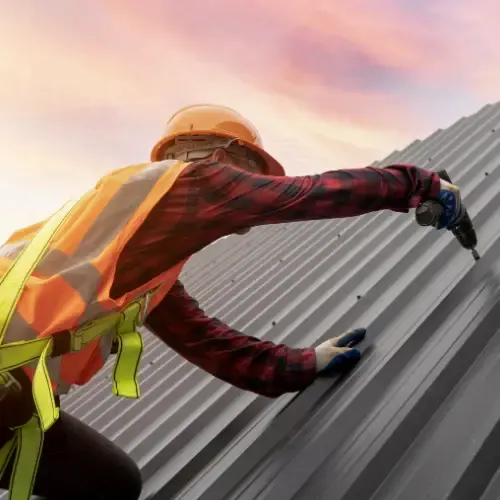
Shed Roof
A Shed Roof is a single-sloped roof that slopes in one direction, creating a simple and clean design. Picture a modern home with a flat, slanted roof, and you’re envisioning a Shed Roof. This sleek design choice offers a minimalist, contemporary look that has recently gained popularity.
Advantages of Choosing a Shed Roof
Modern Aesthetics: Shed Roofs are synonymous with contemporary design. They give your property a clean, uncluttered, stylish, and versatile appearance.
Efficient Water Drainage: The single-sloped design ensures efficient water runoff, reducing the risk of ponding and leaks. This design is perfect for areas that receive heavy rainfall or snowfall.
Space Utilization: Shed Roofs provide an opportunity to utilize the roof space effectively. You can create rooftop gardens, install solar panels, or design a rooftop deck for added functionality.
Practical Applications
Modern Homes: Shed Roofs are an excellent fit for modern architectural styles, where they complement the clean lines and minimalist aesthetics beautifully.
Green Roofing: Shed Roofs are perfect for implementing green roofing solutions, such as garden roofs or solar panel installations, to boost energy efficiency and sustainability.
Commercial Buildings: Many commercial properties, from office buildings to retail spaces, opt for Shed Roofs to maximize usable space and create a sleek, professional look.
Final Word
Whether you choose a mansard roof or prefer the simplicity of gable roofs, each has its own pros and cons. Understanding these can help you make the right choice. If you are still trying to decide on a roof type for your home, ask a professional for help. Roofing professionals with years of experience usually have the knowledge to help you make the right decision.
FAQs
Q. What are the different roof styles?
A. Different roof styles include gable, hip, flat, shed, mansard, gambrel, butterfly, dome, and more.
Q. What are the two most common roof styles?
A. The two most common roof styles are gable roofs and hip roofs.
Q. What are the 2 basic roof framing types?
A. The two basic roof framing types are rafters and trusses.
Q. What is gable roof type?
A. A gable roof is characterized by two sloping sides that meet at a ridge, forming a triangular shape at each end.
